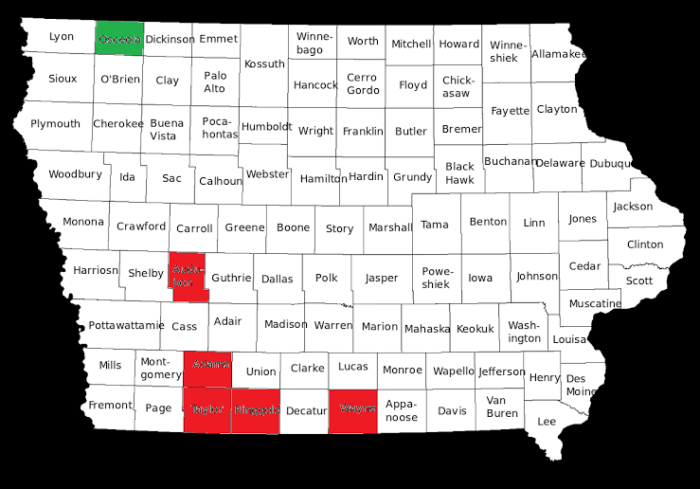The series continues; previous installments are here. -promoted by desmoinesdem
This week I will review our sixth-smallest county in terms of population, Osceola County. The 2010 census found 6,462 people living in the entire 399 square miles, the 3rd smallest in Iowa. To put this in perspective, Osceola County is roughly equal in population to the city of Oelwein (Fayette County).
Osceola County is north and just a bit west of Des Moines, bordering Minnesota on its north border. The highest point in Iowa, Hawkeye Point is located within the county. According to Google Maps, the county seat of Osceola County, Sibley, is 236.1 road miles from the Iowa State Capitol building in Des Moines. Osceola County was founded in 1871 when it was separated from Woodbury County, and was the last county established in Iowa. The county was named after the Seminole chief Osceola.
In contrast to the previous five counties covered in this series, the highest population in Osceola County (10,607) was in the 1940 census. Osceola County has lost population in every census since that time.
The racial makeup of the county in the 2010 census was 98.04 percent White, 0.11 percent Black or African American, 0.26 percent Native American, 0.20 percent Asian, 0.01 percent Pacific Islander, 0.84 percent from other races, and 0.53 percent from two or more races. 1.78 percent of the population were Hispanic or Latino of any race. Some 10.6 percent of the population live in households with income at or below the poverty level.
Average personal income was estimated at $39,810 which was the 33rdth highest of Iowa’s 99 counties. Osceola County had the 16th lowest unemployment rate in 2010 (tied with several others), 4.9 percent. (As of December 2016 the unemployment rate was 3.1 percent.)
In terms of educational attainment, Osceola County has the 36th lowest rate of residents having received a bachelors degree or higher, 16.3 percent. The overall rate in Iowa is 24.8 percent, as a comparison.
Osceola County is currently a part of the Fourth Congressional district and has been represented by Steve King (R) since 1993. Currently Osceola County is a part of Iowa Senate district 1, represented by David Johnson (I) (formerly R) and part of Iowa House district 1, represented by John Wills (R).
2016 Elections Results
Donald Trump 2,531 (78.8 percent) Hillary Clinton 552 (17.2 percent) Others 130 (4 percent)
US Senate Chuck Grassley 2,601 (82.8 percent) Patty Judge 455 (14.5 percent) Others 87 (2.3 percent)
US House Steve King 2,375 (77.3 percent) Kim Weaver 694 (22.6 percent) Other 2 (0.1 percent)
Iowa Senate- No Race
Iowa House- John Wills-R 2,695 (99.4 percent) Other 17 (0.6 percent) NO DEMOCRATIC CANDIDATE
Since 1960, the Republican Nominee has carried Osceola County 14 times and the Democratic Nominee 1 time, with the most recent Democratic victory in 1964. Romney carried Osceola county in 2012 by 41.27 percent while Trump won in 2016 with a 61.6 percent advantage!
The Osceola County Board of Supervisors has a 5-0 Republican monopoly. All county elected officials are Republican. In the 2014 and 2016 elections, there were no Democrats running in local elections in Osceola County.
Looking back at the 2014 elections, David Johnson was unopposed in the Iowa Senate race, as was John Wills in the Iowa House race. Joni Ernst carried Osceola County with 59.3 percent of the vote against Bruce Braley, and Governor Terry Branstad received 69.4 percent against Jack Hatch, so Democrats losing in the county by wide margins is a continuing trend.
While Osceola County was an another electoral disaster for Democrats in 2016, in the county Democrats have not been competitive in Presidential Elections since 1960 with the exception of the national Lyndon Johnson landslide in 1964.
Many 2016 election post mortems have pointed out the disastrous (for Democrats) collapse of support in rural areas that have little demographic diversity. Osceola County is an example where this problem is long standing, and 2016 was marginally worse than recent elections. Democrats cannot expect to find electoral success when losing counties by 62 percent in Presidential elections, 68 percent in Senate elections, and definitely not by failing to have a candidate for Iowa Senate or Senate, or for any County Government races.
Next week: Ida County

